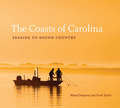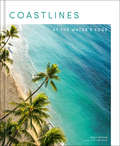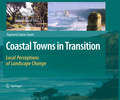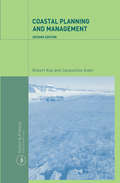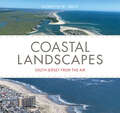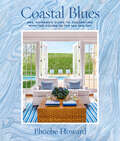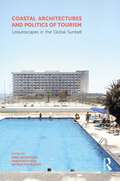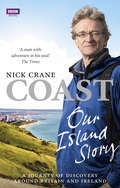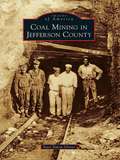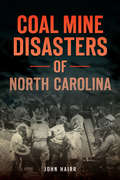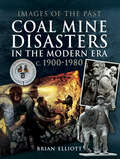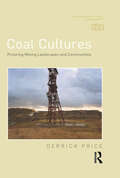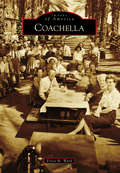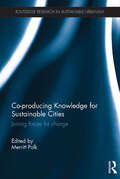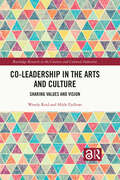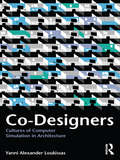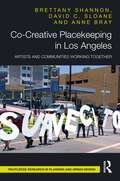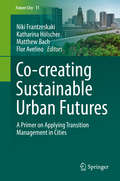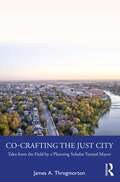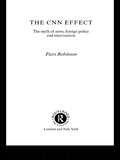- Table View
- List View
The Coasts of Carolina
by Bland Simpson Scott TaylorThe Coasts of Carolinacaptures the vibrancy of the North Carolina oceanfront, sound country, and interior shores behind the barrier islands. Scott Taylor, who has been photographing the coast for almost thirty years, and Bland Simpson, whose many coastal books have delighted readers for two decades, come together to offer an inviting visual and textual portrait organized around coastal themes such as nature, fishing, and community life, with an emphasis on particular places and seasons. Evocative text is woven together with 145 vivid color images to present a unique and welcoming vision of the coastal region. As natives of the area, the collaborators venture beyond the familiar to show us swamp, marsh, river, sound, and seashore, uncovering places of uncommon delight that most visitors rarely lay eyes on. Their work celebrates the beauty of this amazing region and embodies their distinctive sense of what makes the North Carolina coast so special.
Coastlines: At the Water's Edge
by Emily NathanA wanderlust-inspiring photography collection of the world&’s most stunning waterways and coastlines from the premier online curator of travel photography, Tiny Atlas Quarterly. From tropical beaches in Hawai&’i and icy fjords in Greenland to lush mangrove swamps in the Cuban Cayos and forested islands in Vietnam, coastlines and waterways are some of the world&’s most beloved places and most precious habitats. With hundreds of awe-inspiring photos from locations far and wide, Coastlines is a visual tour of these magical watery places and a treasure trove of curated travel information. Water lovers, beach bums, and armchair travelers will enjoy this tranquil exploration of the world&’s many vast and varied shores.
Coastal Towns in Transition: Local Perceptions of Landscape Change
by Raymond James GreenMany coastal areas around the world are experiencing dramatic landscape changes as a result of increased tourism development and the "sea change phenomenon" - the migration of affluent urbanites to small coastal towns seeking beautiful, natural surroundings. In response to these changes local residents in these places often complain that the distinctive character of their towns and/or individual neighborhoods is being lost or degraded. Coastal Towns in Transition looks at how changes due to unsympathetic development of the built environment and modification of the natural landscape are perceived to negatively impact on the character of small coastal towns. The book explores the concept of town character, and associated notions of sense of place, genius loci and place identity, as conceptualised by local residents in several coastal town communities along Australia's Great Ocean Road. Findings of a four-year study involving over 1800 respondents from these communities are used to explore theoretical and methodological issues associated with the assessment of place character in the context of coastal towns that are experiencing rapid environmental change. This book will be of interest to planners and environmental designers, as well as scholars in both landscape studies and social science and planning fields who are interested in the sustainable development of coastal areas. The case studies and associated planning and design strategies, together with the bibliography of selected relevant literature, will provide an invaluable reference for these scholars.
Coastal Planning and Management
by Robert Kay Jaqueline AlderThe first comprehensive tool-kit for coastal planners and those aiming to achieve effective coastal management worldwide. Coastal Planning and Management provides a link between planning and management tools and thus includes all stages in the process, from development through evaluation to implementation. Drawing on examples of successful coastal planning and management from around the world, the authors provide clear and practical guidelines for the people who make daily decisions about the world's coastlines. Coastal Planning and Management is an invaluable resource for professionals in environmental and planning consultancies, international organizations and governmental departments, as well as for academics and researchers in the local and international fields of geography, marine and environmental science, marine and coastal engineering and marine policy and planning.
Coastal Landscapes: South Jersey from the Air
by Kenneth W. AbleNew Jersey has roughly one hundred and thirty miles of coastline, including a wide array of habitats from marshes to ocean beaches, each hosting a unique ecosystem. Yet these coastal landscapes are quite dynamic, changing rapidly as a result of commercial development, environmental protection movements, and of course climate change. Now more than ever, it is vital to document these landscapes before they disappear. Based on numerous aerial images from helicopter and drone flights between 2015 and 2021, this book provides extensive photographs and maps of the New Jersey coast, from the Pine Barrens to the ocean beaches. The text associated with each exceptional image describes it in detail, including its location, ecological setting, and relative position within the larger landscape. Author Kenneth Able, director of the Rutgers University Marine Field Station for over thirty years, has thoroughly ground-truthed each image by observations made through kayaks, boats, and wading through marshes. Calling upon his decades of expertise, Able paints a compelling portrait of coastal New Jersey’s stunning natural features, resources, history, and possible futures in an era of rising sea levels.
Coastal Ghosts and Lighthouse Lore
by William O. ThomsonFrom the Book Jacket: Along the Atlantic Ocean, old homes, inns and lighthouses line the New England coast and give rise to many stories of ghostly apparitions. Old Salts suddenly appear in cemeteries. Victims of lost love roam dark halls. These spirits, happed in time, continue to haunt the towns they once called home. Lighthouse Lore Sea serpents. murders, omens and other strange events are the subject of much New England lighthouse lore. Life was challenging at these lonely outposts on the edge of the sea and the keepers, their families and even their pets faced many dangers and hardships. They were truly dedicated servants of the shore.
Coastal Blues: Mrs. Howard's Guide to Decorating with the Colors of the Sea and Sky
by Phoebe HowardBlue knows no bounds. “Through Howard’s eye, casual elegance meets sophisticated ease, which is revealed through several sea-inspired residences.” —Atlanta Homes & LifestylesFrom design expert (and interior design readers’ favorite) Phoebe Howard comes a new book focused on decorating with beautiful blue color schemes. Coastal Blues is a glorious decor book filled with inspiring images of beach houses, seacoast getaways, vacation cottages, and luxurious seaside manors. It is also a hardworking how-to-get-the-look book that offers solid interior design and styling advice. Featuring brand-new, never-before-published projects, every page reflects the ease and casual elegance of shoreline living. With chapters such as Sea Glass (brilliant blue color schemes), Indigo Bay (true blue schemes), and Ocean Mist (pale blue schemes), Phoebe Howard shows design lovers how to make the coastal style modern, fresh, and very much their own.“Incorporate blue and white into your kitchen and dining area by sticking with white cabinetry but adding splashes of cerulean, azure, and aquamarine on everything from curtains to counter stools, backsplash tiles to bowls. When designing with this classic color combo, you can’t have too much of a good thing.” —Maine Home + Design
Coastal Architectures and Politics of Tourism: Leisurescapes in the Global Sunbelt
by Sibel BozdoǧanThis volume offers a critical and complicated picture of how leisure tourism connected the world after the World War II, transforming coastal lands, traditional societies, and national economies in new ways. The 21 chapters in this book analyze selected case studies of architectures and landscapes around the world, contextualizing them within economic geographies of national development, the geopolitics of the Cold War, the legacies of colonialism, and the international dynamics of decolonization. Postwar leisure tourism evokes a rich array of architectural spaces and altered coastal landscapes, which is explored in this collection through discussions of tourism developments in the Mediterranean littoral, such as Greece, Turkey, and southern France, as well as compelling analyses of Soviet bloc seaside resorts along the Black Sea and Baltic coasts, and in beachscapes and tourism architectures of western and eastern hemispheres, from Southern California to Sri Lanka, South Korea, and Egypt. This collection makes a compelling argument that "leisurescapes," far from being supra-ideological and apolitical spatial expressions of modernization, development, and progress, have often concealed histories of conflict, violence, social inequalities, and environmental degradation. It will be of interest to architectural and urban historians, architects and planners, as well as urban geographers, economic and environmental historians.
Coastal Architectures and Politics of Tourism: Leisurescapes in the Global Sunbelt
by Sibel BozdoǧanThis volume offers a critical and complicated picture of how leisure tourism connected the world after the World War II, transforming coastal lands, traditional societies, and national economies in new ways.The 21 chapters in this book analyze selected case studies of architectures and landscapes around the world, contextualizing them within economic geographies of national development, the geopolitics of the Cold War, the legacies of colonialism, and the international dynamics of decolonization. Postwar leisure tourism evokes a rich array of architectural spaces and altered coastal landscapes, which is explored in this collection through discussions of tourism developments in the Mediterranean littoral, such as Greece, Turkey, and southern France, as well as compelling analyses of Soviet bloc seaside resorts along the Black Sea and Baltic coasts, and in beachscapes and tourism architectures of western and eastern hemispheres, from Southern California to Sri Lanka, South Korea, and Egypt. This collection makes a compelling argument that "leisurescapes," far from being supra-ideological and apolitical spatial expressions of modernization, development, and progress, have often concealed histories of conflict, violence, social inequalities, and environmental degradation. It will be of interest to architectural and urban historians, architects and planners, as well as urban geographers, economic and environmental historians.
Coast: A Journey of Discovery Around Britain's Coastline
by Nicholas CraneAlong our shores, towering cliffs from the age of the dinosaurs rise beside wide estuaries teeming with wildlife, while Victorian ports share waterfronts with imposing fortifications.And the people who have lived, worked and played on this spectacular coast - from Stone Age fishermen to seafarers, chart-makers and surfers - have an incredible tale to tell.Coast: Our Island Story is an enthralling account, sparkling with geography, history, adventure and eccentric characters, told with Nick Crane's trademark charisma and wit.
La coartada perpetua
by Ambrosio FornetUna de las figuras más destacadas de la crítica literaria y cinematográfica cubana reúne en este libro sus mejores ensayos. Preocupado por los problemas que relacionan la historia moderna de Cuba con sus intelectuales, Ambrosio Fornet ha desplegado en sus textos un talento excepcional para definir las líneas del peculiar desarrollo de la cultura cubana a partir de la guerra hispano-cubano-americana de 1898 y de la independencia mediatizada, a la que dio lugar después de tres años de ocupación norteamericana. Tal es el asunto del primero y cuarto ensayos de esta colección. La revolución de 1959 que rompió este proceso neocolonial, inició una ambiciosa experiencia socialista que encontró hasta hoy, en Estados Unidos, un enemigo decidido a destruirla. ¿Cómo esa revolución ha podido, durante más de cuarenta años, resistir ese amenazador enfrentamiento sin abandonar sus propósitos de liberación y justicia social? El segundo ensayo de este libro brinda el "testimonio personal" de Ambrosio Fornet que responde a ese "enigma cubano". El exilio que las medidas revolucionarias cubanas provocaron desde muy pronto y que Estados Unidos propició de manera constante, determinaron la aparición en Estados Unidos de una literatura cubana del exilio que se ha manifestado y se manifiesta tanto en español como en inglés. Los méritos de esta creación literaria exiliada y los conflictos provocados por el bilingüismo han sido un tema en el que Fornet se ha explayado con notable objetividad y brillantez según puede verse en el tercero y sexto ensayos de la colección. El más extenso de todos ellos es una interesantísima "arqueología del nuevo cine latinoamericano (1959-1979)" que hace un balance crítico importante de esa crucial etapa del cine en nuestro subcontinente. Por ultimo, el libro se cierra con un ensayo medular sobre el "testimonio" en cuanto género literario peculiar de América Latina.
Coal Mining in Jefferson County
by Staci Simon GloverUniquely, Jefferson County had all of the elements necessary for the fabrication of iron and steel within its borders. Coal, limestone, and iron ore all lay within close proximity to Birmingham. The right amounts of business acumen, industrial planning, and labor force came together creating the industry that made Birmingham the "Magic City." The coal mining towns in the Birmingham Industrial District have rich histories--a Hollywood movie was made in one, a novel was written about another, and a soccer championship was won in yet another town. These coal towns and the miners who lived in them are as responsible as anyone for the birth of Birmingham industry.
Coal Mine Disasters of North Carolina (Disaster)
by John HairrDuring the past two centuries, the central region of the Tar Heel State was populated with numerous active coal mines, many of which dealt with catastrophes such as cave-ins or gas explosions. Over fifty-three miners lost their lives in an explosion at the Carolina Mine at Coal Glen in 1925, the largest industrial disaster in state history. The Egypt Coal Mine was a key resource for Confederate forces during the Civil War despite a series of explosions that claimed scores of lives. The last efforts by the Raleigh Mining Company to continue coal mining in the state in the 1950s were marred by accidents and signaled an eventual end to the industry. Author John Hairr chronicles the history and tragedy of coal mining in North Carolina’s Deep River region.
Coal Mine Disasters in the Modern Era c. 1900–1980 (Images of the Past)
by Brian Elliott&“These haunting images, with well-researched facts, figures and timelines providing context, bring the bygone era of 20th-century coal mining to life.&”—Family Tree Although everyday fatalities in mines was far greater, it was the disasters that encouraged those in power to reform the way in which miners had to work underground, especially with regard to safety. And it would be no exaggeration to say that it was the disasters that greatly contributed to bringing the coal industry into national control. Sadly, for bereaved individuals and families, nothing could really compensate for the loss of one or more of a loved one. The impact of the big disasters, where hundreds of men and boys—one or two generations—were lost, immediately, the impact was massive, and continued to be felt many years afterwards. New and restored disaster memorials bear testimony to the great respect that former mining communities continue to have for their &“lost miners.&” Using many previously unpublished images, and a carefully supportive text, the author provides a detailed overview of mining disasters in the modern era, from the early 1900s to the 1980s. It is the first book of its kind to attempt such a large project in pictorial form with a foreword by Ceri Thompson, curator of the Big Pit, the Welsh national mining museum. The book is published at a particularly poignant time, after the recent closure of Britain&’s last deep coal mine. &“So many remarkable photographs and drawings: The story may be tragic, but it is one that lies at the very heart of the history of coal mining in Britain.&”—WDYTYA? magazine
Coal Cultures: Picturing Mining Landscapes and Communities (Photography, Place, Environment)
by Derrick PriceCoal is the commodity that powered the technologies that made the modern world. It also brought about unique communities marked by a high degree of social solidarity and self-help. Mining was central to working class life, drawing rural populations into industrial labour, but it often took place in picturesque landscapes, so that its black spoil heaps became a central symbol of the degradation of pastoral life by the demands of an extractive industry. Throughout Europe and the USA photographers have pictured the characteristic landscapes of the industry, and continue to do so as strip mining devastates huge areas of land. Not only landscape photography but also documentary, portraiture, photojournalism and art photography have been used in order to portray mines and miners. This book presents three interlinked strands of investigation. The first is the way in which the production of coal created paradigmatic communities grounded in particular landscapes. The second concerns the role of photography in exploring, delineating and critiquing mining communities. This in turn involves an examination of the aesthetic and social characteristics of a number of genres of photography. Lastly, it considers the growth and decline of these sites, the geographic shift of the industry to other places, and the re-presentation of traditional localities through the lens of the heritage industry and industrial tourism.
Coachella (Images of America)
by Erica M. WardCoachella was founded by Jason L. Rector in 1884 under the name of Woodspur. Rector established a wood siding for the railroad company and cleared the mesquite trees in the local area. As the town developed with the guidance and hard work of the early residents, the town elected to change its name to Conchilla in 1901. However, a clerical error would result in the town's name being registered as Coachella. The growth and development of the town would steadily continue while the agricultural industry took advantage of the year-round growing season. The unique development of the date industry in Coachella and the surrounding towns provided a strong economy for local residents. Flourishing in the unforgiving extreme heat of the Coachella Valley remains a testament to the ingenuity of the people of this desert valley.
CO2 Pistols & Rifles
by James HouseCurrent safety trends encourage shooters to opt for guns of less power, especially CO2-powered guns. Several airgun shooters are not required to go through the traditional buying procedures of high-powered pistols and rifles, such as background checks and waiting periods. Plus, companies such as Colt, Smith & Wesson, and Walther manufacture high quality CO2 products that are visually indistinguishable from their traditional firearms. In this new guide to CO2-powered pistols and rifles, James E. House offers a comprehensive history of CO2 guns, dating back to the 1930s, and a discussion of propulsion, pellets, and sights. Beginning shooters are introduced to the market with a complete analysis on performance and accuracy of currently available products. Airgun enthusiasts are reunited with CO2 classics no longer being manufactured. This book also offers additional sections on target shooting, games, and varmints. Offers a comprehensive history of CO2 pistols and rifles dating back to the 1930s Includes a categorical review of BB pistols, .177 caliber pistols, .20 and .22 caliber pistols, and rifles Discover products currently available only on the secondary market
Co-producing Knowledge for Sustainable Cities: Joining Forces for Change (Routledge Research in Sustainable Urbanism)
by Merritt PolkAt the current time, many issues and problems within sustainable urban development are managed within traditional disciplinary and organizational structures. However, problems such as, climate change, resource constraints, poverty and social tensions all exceed current compartmentalization of policy-making, administration and knowledge production. This book provides a better understanding of how researchers and practitioners together can co-produce knowledge to better contribute to solving the complex challenges of reaching sustainable urban futures. It is written for academic and professional audiences working with urban planning and sustainable cities around the world. Co-producing Knowledge is presented, by way of introduction, as a non-linear, collaborative approach to knowledge production which combines interdisciplinary, transdisciplinary, cross sector and policy approaches to societal problem solving. Examples are taken from Cape Town, Gothenburg, Kisumu, Manchester, Melbourne and a selection of cities in Southeast Asia. Each city chapter discusses the drivers and motivations behind knowledge co-production and gives concrete examples of activities and approaches that have been used to promote sustainable urban futures. Each chapter is written to promote mutual learning from the approaches that are already in use. Building upon these city cases, the conclusions outline an international practice and research agenda aimed at strengthening the promotion and implementation of the knowledge co-production for sustainability across diverse urban development contexts. This book provides an overview of the diverse driving forces behind co-production, and their specific contexts and constraints in a variety of cosmopolitan urban contexts. Some of these include institutional and cross-sector barriers to co-production, the need for learning across diverse levels and contexts, and strategies for balancing scientific excellence with the needs of societal change. This book offers valuable lessons regarding the concrete implications and potential impact that co-production processes can have for different user groups, such as planners, politicians, researchers, business interests and NGOs in different urban development contexts.
Co-Leadership in the Arts and Culture: Sharing Values and Vision (Routledge Research in the Creative and Cultural Industries)
by Wendy Reid Hilde FjellværThis book is about co-leadership: a leadership practice and structure often found in arts organizations that consists of two or three executives who bridge the art and business divide at the top. Many practitioners recognize this phenomenon but the research on this topic is limited and dispersed. This book assembles a coherent overview and presents new insights of the field. While co-leadership is well institutionalized in the West, it is also criticized for management’s constraint of artistic autonomy and for its pluralism that dilutes leadership clarity. However, co-leadership also personifies the strategic objectives of art, audiences, organization, and community, by addressing plural logics - navigating the demands of artistic vision and organizational stability. It is an integrating solution. The authors investigate its specifics in the arts, including global practice and its interdisciplinary nature. The theoretical frame of plural leadership supports their empirical explorations of the dynamics within the co-leadership relationship and with organizational stakeholders. Data includes the voices of co-leaders, artists, staff, and board members from arts organizations in Canada and Norway. Their abductive reflection generates a stimulating research experience. By viewing co-leadership in action, not as a study of static theories, the book will appeal not only to students and researchers but also resonate with practitioners in arts and cultural management and assist them to work with co-leadership and to manage its tensions.
Co-Leadership in the Arts and Culture: Sharing Values and Vision (Routledge Research in the Creative and Cultural Industries)
by Wendy Reid Hilde FjellværThis book is about co-leadership: A leadership practice and structure often found in arts organizations that consist of two or three executives who bridge the art and business divide at the top.Many practitioners recognize this phenomenon but the research on this topic is limited and dispersed. This book assembles a coherent overview and presents new insights of the field. While co-leadership is well institutionalized in the West, it is also criticized for management’s constraint of artistic autonomy and for its pluralism that dilutes leadership clarity. However, co-leadership also personifies the strategic objectives of art, audiences, organization, and community, by addressing plural logics – navigating the demands of artistic vision and organizational stability. It is an integrating solution. The authors investigate its specifics in the arts, including global practice and its interdisciplinary nature. The theoretical frame of plural leadership supports their empirical explorations of the dynamics within the co-leadership relationship and with organizational stakeholders. Data includes the voices of co-leaders, artists, staff, and board members from arts organizations in Canada and Norway. Their abductive reflection generates a stimulating research experience.By viewing co-leadership in action, not as a study of static theories, the book will appeal not only to students and researchers but also resonate with practitioners in arts and cultural management and assist them to work with co-leadership and to manage its tensions.
Co-Designers: Cultures of Computer Simulation in Architecture
by Yanni LoukissasDesigners employ a variety of tools and techniques for speculating about buildings before they are built. In their simplest form, these are personal thought experiments. However, embracing advanced computer simulations means engaging a network of specialized people and powerful machines. In this book, Yanni Alexander Loukissas demonstrates that new tools have profound implications for the social distribution of design work; computer simulations are technologies for collective imagination. Organized around the accounts of professional designers engaged in a high-stakes competition to redefine their work for the technological moment, this book explores the emerging cultures of computer simulation in architecture. Not only architects, but acousticians, fire safety engineers, and sustainability experts see themselves as co-designers in architecture, engaging new technologies for simulation in an evolving search for the roles and relationships that can bring them both professional acceptance and greater control over design. By illustrating how practices of simulation inform the social relationships and professional distinctions that define contemporary architecture, the book examines the cultural transformations taking place in design practice today.
Co-Creative Placekeeping in Los Angeles: Artists and Communities Working Together (Routledge Research In Planning And Urban Design Ser.)
by Brettany Shannon David C. Sloane Anne BrayCo-Creative Placekeeping in Los Angeles is a novel examination of Los Angeles-based socially engaged art (SEA) practitioners’ equitable placekeeping efforts. A new concept, equitable placekeeping describes the inclination of historically marginalized community members to steward their neighborhood’s development, improve local amenities, engage in social and cultural production, and assert a mutual sense of self-definition—and the efforts of SEA artists to aid them. Emerging from in-depth interviews with eight Southern California artists and teams, Co-Creative reveals how artists engage community members, sustain relationships, and defy the presumption that residents cannot speak for themselves. Drawing on these artists and theoretical analysis of their praxes, the book explicates equitable community engagement by exploring not just the creative projects but also the underlying phenomena that inspire and sustain them: community, engagement, relationships, and defiance. What further sets this book apart is how it deviates from the conventional who and what of SEA projects to foreground the how and the why that inspire and necessitate collectively creative action. Co-Creative is for anyone studying arts-based community development and gentrification, given it complicates and enriches the current conversation about art’s undeniable and increasingly controversial role in neighborhood change. It will also be of interest to researchers and students of urban studies.
Co-creating Sustainable Urban Futures: A Primer on Applying Transition Management in Cities (Future City #11)
by Niki Frantzeskaki Katharina Hölscher Matthew Bach Flor AvelinoThis is a unique book that provides rich knowledge on how to understand and actively contribute to urban sustainability transitions. The book combines theoretical frameworks and tools with practical experiences on transition management as a framework that supports urban planning and governance towards sustainability. The book offers the opportunity to become actively engaged in working towards sustainable futures of cities. Readers of this book will be equipped to understand the complexity of urban sustainability transitions and diagnose persistent unsustainability problems in cities. Urban planners and professionals will build competences for designing transition management processes in cities and engaging with multidisciplinary knowledge in solution-seeking processes. The heart of the book marks the variety of very different local case studies across the world - including, amongst others, Rotterdam in the Netherlands, La Botija in Honduras, Sydney in Australia and Cleveland in the US. These rich studies give inspiration and practical insights to young planners on how to create sustainable urban futures in collaboration with other stakeholders. The case studies and critical reflections on applications of transition management in cities offer food for thought and welcome criticism. They also introduce new lenses to understand the bigger picture that co-creation dynamics play in terms of power, (dis-)empowerment, legitimacy and changing actor roles. This will equip the readers with a deep understanding of the dynamics, opportunities and challenges present in urban contexts and urban sustainability transitions.
Co-Crafting the Just City: Tales from the Field by a Planning Scholar Turned Mayor
by James A. ThrogmortonThe 2016 election in Iowa City would provide an opportunity that planning faculty have long desired: the opportunity for one of their own to serve as mayor. In this new book, former Iowa City Mayor and Professor Emeritus James A. Throgmorton provides readers a sense of what democratically-elected city council members and mayors in the United States do and what it feels like to occupy and enact those roles. He does so by telling a set of “practice stories” focusing primarily, but not exclusively, on what he, a retired planning professor at the University of Iowa, experienced and learned as a council member from 2012 through 2019 and, simultaneously, as mayor from 2016 through 2019. The book proposes a practical, action-oriented theory about how city futures are being (and can be) shaped, showing that storytelling of various kinds plays a very important but poorly understood role in the co-crafting process, and demonstrating that skillful use of ethically-sound persuasive storytelling (especially by mayors) can improve our collective capacity to create better places. The book documents efforts to alleviate race-related inequities, increase the supply of affordable housing, adopt an ambitious climate action plan, improve relationships between city government and diverse marginalized communities, pursue more inclusive and sustainable land development codes/policies, and more. It will be of great interest to urban planning faculty and students and elected officials looking to collaboratively craft better cities for the future.
The CNN Effect: The Myth of News, Foreign Policy and Intervention
by Piers RobinsonThe CNN Effect examines the relationship between the state and its media, and considers the role played by the news reporting in a series of 'humanitarian' interventions in Iraq, Somalia, Bosnia, Kosovo and Rwanda. Piers Robinson challenges traditional views of media subservience and argues that sympathetic news coverage at key moments in foreign crises can influence the response of Western governments.
